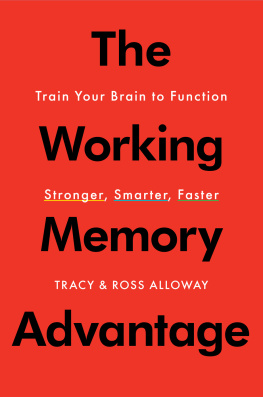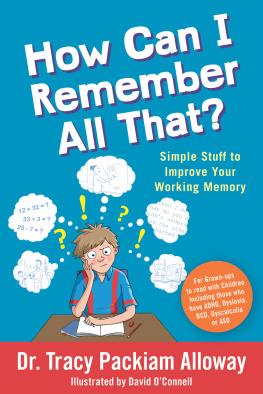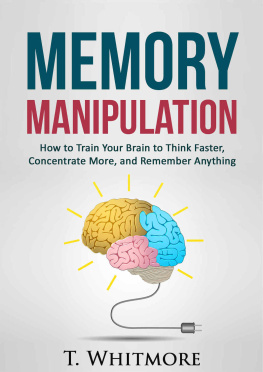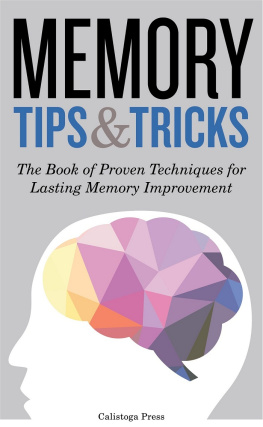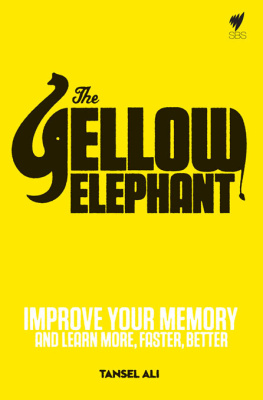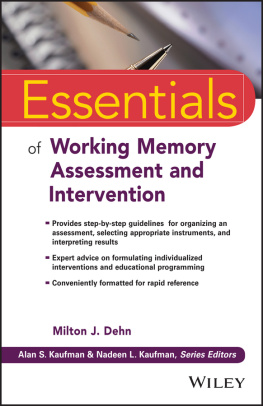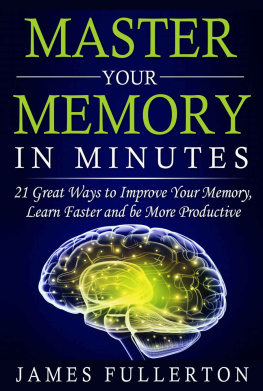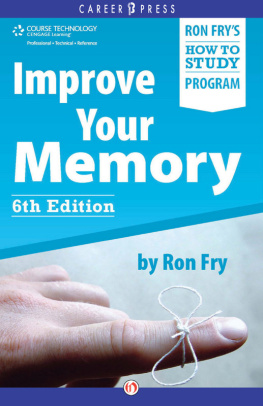Thank you for downloading this Simon & Schuster eBook.
Join our mailing list and get updates on new releases, deals, bonus content and other great books from Simon & Schuster.
C LICK H ERE T O S IGN U P
or visit us online to sign up at
eBookNews.SimonandSchuster.com
C ONTENTS
For our little heroes, M. and M.
P ART I

Working Memory and You
1
Welcome to the Working Memory Advantage
I N D ECEMBER 2005 , a broker on the Tokyo stock exchange sold 610,000 shares of a company called J-Com, for the low, low price of 1 yen, an amount less than a penny. The problem is that he meant to sell one single share for 610,000 yen. Epic oops. In 2001, a London dealer sold million pounds sterling worth of shares when he intended to sell only million pounds. The trade sparked a panic in the market that caused 30 billion pounds to go up in smoke.
Brokers may process mountains of information when deciding what to sell and buy, but in the heat of the moment, all it takes is just one extra piece of informationthe ring of a phone, the flash of a screen, the thrill of being responsible for such a large sum of moneyand their focus is lost. No longer able to process all the information, they struggle to check orders carefully. Trading is a profession that places high demands on a foundational cognitive skill called working memory .
By working memory advantage , we mean that this skill gives you a leg up, a boost in life. As you will discover, working memory offers you an advantage in a huge range of activities: from the everyday, like giving an important presentation at work, to the extreme, like ripping down an eighty-foot wave. It helped our evolutionary ancestors to advance from just surviving to thriving. It enabled our technological trajectory: from a bone club used for bashing to an iPhone used for connecting. By ignoring, overloading, or undermining your working memory, you put yourself at a huge disadvantage. But by focusing on your working memory, taking it into account, and improving it, the skys the limit. We wrote this book in order to give everyone an opportunity to take advantage of this life-changing skill.
In the past decade, research on working memory has exploded. It is fast emerging as one of the most widely researched cognitive functions of the twenty-first century, and we have been leading participants in much of this research. Tracy developed a groundbreaking and highly accurate standardized working memory test for use by educators and has dedicated much of her research career to investigating the role of working memory in education and learning difficulties. Ross has focused his attention on developing exercises to improve working memory, and as the CEO and founder of Memosyne, Ltd., he developed working-memory-training software called Jungle Memory that has been used by thousands of students. Together, they have examined the role of working memory in a variety of contexts, such as how it changes when you get older; how it is linked to happiness; how it relates to lying; how it is affected by activities like barefoot running; and how it is influenced by social media like Facebook.
What Is Working Memory?
Working memory is our ability to work with information. More precisely, working memory is the conscious processing of information . By conscious, we mean that the information is on your mind. You are giving attention to it, shining a mental spotlight on it, concentrating on it, or making decisions about it. You are also intentionally ignoring everything else. If you are thinking about a stock trade, for example, you are filtering out the ringing phones, the jabbering of your coworkers, and the excitement of placing a $1 million order. By processing , we mean that you are manipulating the information, working with it, making calculations with it, or reformulating it.
The classic example of a job that requires a strong working memory is that of an air traffic controller, whose job is to maintain the safe and orderly flow of air traffic. With hundreds of planes taking off and landing every hour, an air traffic controller must have the mental agility to process multiple variables, such as equipment, weather patterns, traffic volume, precise communication with pilots, and quick calculations. In times of emergency, they must be able to make split-second decisions while effectively moderating the stress of knowing that the lives of pilots and passengers are in their hands.
We see a strong working memory giving us an advantage at play in many aspects of everyday life too. It allows you to listen to your spouse while checking your smart phone and making pancakes for the kids. It lets you complete a complicated spreadsheet in spite of interruptions from your constantly ringing phone and the din of annoyingly loud coworkers. Working memory gives you the ability to remain focused on the conversation with your dinner date while ignoring the urge to check the hockey score on your mobile.
Working Memory in the Brain
For more than the past decade, scientists have been using advanced brain imaging to examine how working memory functions in the brain. Their results reveal that using working memory involves a number of areas in the brain. On the next page are some of the major players:

Major Players in Working Memory
Prefrontal cortex (PFC) : The PFC is the home of working memory. Located in the front of the brain, the PFC coordinates with other areas of the brain through electrical signals and receives information from those regions so your working memory can make use of it. Brain-imaging scans show that when working memory is being used, the PFC glows while it fires thoughts to and works with information from the different brain regions. Working memory is the primary function of the PFC. Though the PFC is the area most often associated with working memory, it is important to note that scientists have also found activation in other areas of the brain, such as the parietal cortex and the anterior cingulate, when people perform a working memory task.
Hippocampus : The hippocampus is where the vast amount of knowledge you have acquired over your lifetime is housed for long-term storage. It is the location of long-term memory (LTM). Your working memory allows you to sift through all the information you have stored in your long-term memory, and pull out the bits most relevant to the task at hand. It gives you the ability to combine that stored knowledge with new information coming in, and to put new information into your long-term memory.
Amygdala : The amygdala is the brains emotional center. When you are experiencing a strong emotion, like fear, your amygdala is activated. Working memory is also important to emotional control, managing the emotional information coming from the amygdala and preventing it from distracting you from the task youre working on. If someone yells Fire! in the movie theater, your working memory would help you to control the fear coming from your amygdala so that you can exit in an orderly fashion without creating a panic.
Intraparietal sulcus : Located at the top back portion of the brain, the intraparietal sulcus is the brains math center. When you need to perform calculations, such as in choosing the best mortgage loan or guesstimating how many more miles you can go on a quarter tank of gas, your working memory relies on it to get the answer. In fact, the intraparietal sulcus is so important to math skills that when researchers used mild electrical currents in order to take it offline, participants struggled to perform simple math tasks, like deciding whether 4 was bigger than 2.
Next page
